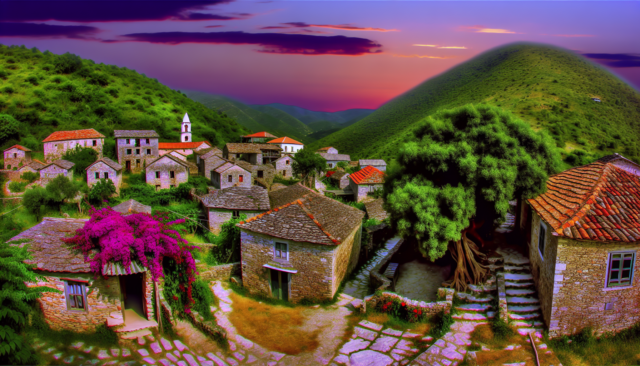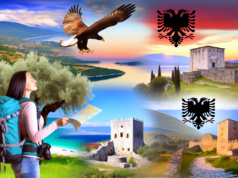
Nestled amidst the rugged mountains, lush valleys, and pristine coastlines, Albania offers a treasure trove of picturesque villages that are like portals to a simpler time. With their rich history, unique architecture, and vibrant local culture, these villages are not just mere destinations; they are experiences that invite travelers to step back in time. In this article, we will explore some of the most unforgettable Albanian villages that showcase the beauty and diversity of this Balkan gem.
1. Gjirokastër: The City of Stone
A UNESCO World Heritage Site, Gjirokastër is often referred to as the “City of Stone” due to its well-preserved Ottoman-era architecture. The village’s iconic cobbled streets wind through a hillside dominated by the impressive Gjirokastër Castle, which dates back to the 12th century. As you wander through the village, you will discover charming stone houses adorned with wooden balconies, many of which have been converted into quaint guesthouses and cafes.
One of Gjirokastër’s most notable features is the Ethnographic Museum, located in the former home of Enver Hoxha, the country’s communist dictator. Here, visitors can learn about traditional Albanian life, customs, and crafts. As the sunset casts a warm glow over the village, it creates a magical atmosphere that feels like a scene from a bygone era.
2. Berat: The Town of a Thousand Windows
Often called the “Town of a Thousand Windows,” Berat is another UNESCO World Heritage Site that enchants visitors with its stunning blend of cultural influences. Set against the backdrop of the Tomorr Mountain, the village is characterized by its white Ottoman-era houses cascading down the hillside, each with numerous windows that seem to gaze out over the River Osum.
Berat’s rich history is evident in its myriad of historic sites, including the Berat Castle, which houses numerous churches and a mosque. The Onufri National Museum, located within the castle, showcases religious art that reflects the area’s long-standing traditions. A stroll through Berat’s ancient streets is akin to walking through history, as the echoes of its diverse past resonate in the architecture and local traditions.
3. Dhërmi: The Coastal Retreat
For those seeking a touch of the Mediterranean, Dhërmi is an unforgettable village perched on the Albanian Riviera. Its stunning beaches, crystal-clear waters, and vibrant nightlife make it a popular summer destination. However, it is the village’s well-preserved traditional architecture and charming atmosphere that truly captivate the soul of visitors.
In Dhërmi, visitors can explore narrow winding streets, quaint shops, and local tavernas serving fresh seafood and traditional Albanian dishes. More than just a beach getaway, Dhërmi offers a glimpse into the traditional way of life, where the scent of wild thyme and the sound of laughter blend with the gentle sea breeze.
4. Kela, the Last Village
Kela, located in the remote mountainous region of Albania, is a hidden gem that remains relatively untouched by modernity. Known as “the last village,” Kela is a testament to Albania’s rustic charm and resilient way of life. Visitors to Kela are greeted by breathtaking landscapes, with towering peaks and verdant valleys that seem to stretch endlessly.
In Kela, traditional stone houses, vibrant flower gardens, and the hospitality of the local people create an inviting atmosphere reminiscent of simpler times. The village is a place where time stands still, and visitors can enjoy activities ranging from hiking in the surrounding mountains to experiencing local customs and traditional crafts.
5. Shtëpisë: The Enchanted Village
Nestled in the heart of the Albanian Alps, Shtëpisë is a hidden paradise known for its stunning natural beauty and rich folklore. The village is framed by snow-capped peaks and lush green valleys, making it perfect for outdoor enthusiasts and those seeking serenity. Shtëpisë is home to traditional wooden houses, many of which date back centuries, and the village’s isolation preserves an authentic Albanian way of life that feels both charming and spellbinding.
Travelers can participate in local festivities that celebrate traditional music, dance, and food. Shtëpisë is not just a village; it is a community where ancient customs continue to thrive, offering visitors a deep connection to the history and heritage of Albania.
Conclusion
Albania’s unforgettable villages are a testament to the country’s rich culture and vibrant history. From the stone streets of Gjirokastër to the tranquil shores of Dhërmi, each village tells its own story, inviting travelers to immerse themselves in the warmth and hospitality of its people. For those seeking a genuine escape from the modern world, these villages are more than just travel destinations; they are gateways to a timeless experience that leaves an indelible mark on the soul. What better way to understand the heart of Albania than to wander through its unforgettable villages, where history and tradition come alive?













